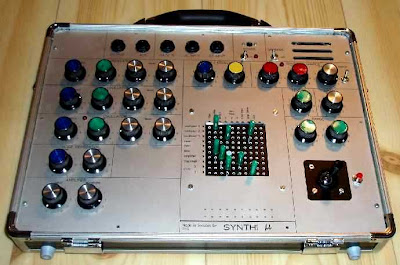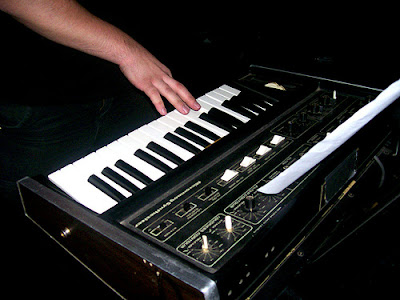
Friday, April 20, 2007
Roland SH-101
Specifications:
* Type: Synth/ keyboard/
* Synthesis Type: Analog subtractive
* Polyphony:
o Max: 1
o Typical in use: 1
* Multi-timbral (number of parts): 1
* Oscillators per Voice :
o Min : 1
o Max : 3
* Controllers : GATE OUT/In and CV out/IN
* Drum Section :
o Number of Drum Kits : 0
o Number of Drum sounds : 0
* Keyboard :
o Number of Keys : 3 octaves
o Can send on simultaneous MIDI channels
* Memory :
o Patches : 0
o Performances : 0
* Inputs and Outputs :
o Number of Audio Outs (excluding Phones) : 1
o Number of Audio Ins : 2
o Number of MIDI Outs (excluding Thru) :
o Number of MIDI Ins :
* Upgrade Options : This is one of the most easily modifiable analog synths. Analogue Solutions sells kits for making it MIDI, giving you INPUTS to the filter or making it COMPLETELY MODULAR(everything can be crosspatched with other CV-gear).
Thursday, April 19, 2007
Celebration of Max Mathews and 50 Years of Computer Music
Update: check the comments for one more date on April 30 in San Francisco.
"Date: Wed, Apr 18 2007 1:46pm
From: "Computer History Museum"
CCRMA and CHM Present
A Celebration of Max Mathews and 50 Years of Computer Music
Fifty years ago, in 1957, at Bell Telephone Laboratories, Max Mathews demonstrated that the digital computer can be used as a fantastic new musical instrument. He created a revolutionary software platform destined to form the basis of all contemporary digital musical systems.
His audacious ideas were driven by the belief that any sound that the human ear can hear can be produced by a computer. Mathews' mastery of this new instrument revealed new musical horizons and sparked a burgeoning curiosity into the very nature of sound. His comprehension and elaboration made five decades of art and research ossible, laying the groundwork for generations of electronic musicians to synthesize, record, and play music. Today at Stanford's Center for Computer Research in Music and Acoustics (CCRMA) as a Professor Emeritus he continues not only to educate students and colleagues, but also to guide and inspire with his constant inventiveness and pure musical pleasure.
Join us in honoring Max for an afternoon of sound, celebration and discovery of his ideas,works, music, and writings.
WHEN
SUNDAY, April 29, 2007
4 p.m. Pre-concert talk
Jon Appleton, John Chowning, Evelyne Gayou, Max Mathews, Jean-Claude Risset
5 p.m. ìInfluences: A Tribute Concertî
Jon Appleton, Gerald Bennett, Chris Chafe, Evelyne Gayou, Max Mathews,
Dexter Morrill, Jean-Claude Risset
6:00 p.m. Reception
WHERE
Computer History Museum
Hahn Auditorium
1401 N. Shoreline Blvd.
Mountain View, CA 94043
www.computerhistory.org/about/directions/
REGISTRATION
Free.
To register or for more information on the event, please visit the Museum's
Website at http://www.computerhistory.org/max_guest_04292007 or Call (650) 810-1005."
via loscha.
The KORG MS-911
 Another via Perry.
Another via Perry."This is a Korg X-911 that I have re-built to a modular synth. The original X-911 Guitar Synth actually contains much more than is obvious on the front pane"
Title link takes you to more detail.
Prophet5.org - New Prophet 5 Forum
EMS Synthi AKS
 Title link takes you to a couple more shots via this auction.
Title link takes you to a couple more shots via this auction.Update: Apparently this is the same one as my previous post. Doh! This is a good shot, so I'll just leave it up... : ) BTW, I've been up since 1:00 AM PST and it is now 8:23 PM PST. I had a 7:00 AM eastern flight from Hartford Connecticut back to Seattle. I got up at 4:00 AM EST which is 1:00 AM PST, so that's my excuse...
The Synthi Micro
 "This is a sort of clone of the EMS Synthi A. Well, not a clone really, since it has none of the electronics like the EMS, nor has it the complete amount of functions. It is also smaller then the original. I wanted a synth that could do the typical effect sounds that the Synthi A is known for. At first, I designed an even smaller synth, with a minimum of modules and functions, and no pin matrix. But after a while I realized this design would be far too limited, and I also wanted the routing capability of a matrix. So this is what it turned out to be. I used a lot of stuff that I happened to have laying around in the junc box; like the 10x10 pin matrix, a small reverb tank, CEM3340:s etc."
"This is a sort of clone of the EMS Synthi A. Well, not a clone really, since it has none of the electronics like the EMS, nor has it the complete amount of functions. It is also smaller then the original. I wanted a synth that could do the typical effect sounds that the Synthi A is known for. At first, I designed an even smaller synth, with a minimum of modules and functions, and no pin matrix. But after a while I realized this design would be far too limited, and I also wanted the routing capability of a matrix. So this is what it turned out to be. I used a lot of stuff that I happened to have laying around in the junc box; like the 10x10 pin matrix, a small reverb tank, CEM3340:s etc."Title link takes you to the specs. Via Perry. Update: mp3s are now at the bottom of the page. You have to use the inside scroll bar to scroll down. There are also some really nice images.
Solar photosynth
YouTube via jonjb2a.
"Synthstick circuit with resistor replacing potentiometer. Circuit powered by three solar cells. Instrument has no moving parts; "played" in manner similar to that of theremin or tannerin, regardless of vast differences between it and the other instruments."
Solar powered?
via sendling
PREVIOUS PAGE
NEXT PAGE
HOME













© Matrixsynth - All posts are presented here for informative, historical and educative purposes as applicable within fair use.
MATRIXSYNTH is supported by affiliate links that use cookies to track clickthroughs and sales. See the privacy policy for details.
MATRIXSYNTH - EVERYTHING SYNTH













© Matrixsynth - All posts are presented here for informative, historical and educative purposes as applicable within fair use.
MATRIXSYNTH is supported by affiliate links that use cookies to track clickthroughs and sales. See the privacy policy for details.
MATRIXSYNTH - EVERYTHING SYNTH





























